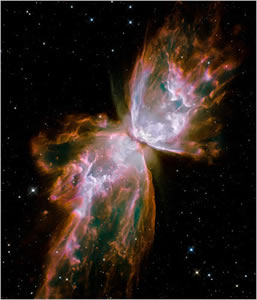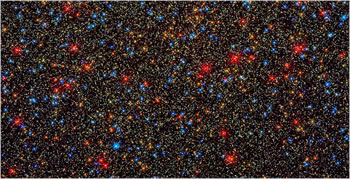Transcendent and Immanent:
Honoring God's Mystery, Embracing His Goodness
For Sunday September 27, 2009
Lectionary Readings (Revised Common Lectionary, Year B)
Esther 7:1–6, 9–10, 9:20–22 or Numbers 11:4–6, 10–16, 24–29
Psalm 124 or Psalm 19:7–14
James 5:13–20
Mark 9:38–50
It's scary to consider just how idolatrous our ideas about God can be. We chop God down to our size, create him in our own image, and imagine that he loves all that we love and hates all the people we hate. Like the psalmist for this week, we boast that "God is on our side" and will destroy our enemies (124:1). Instead of worshipping the Wholly Other one who transcends all creation and cosmos, we tuck God into our back pockets where he remains nice, safe, and silent.
In his article in The New Yorker (August 31, 2009), James Wood observes how in order to avoid such primitive images of God, some of the most vociferous anti-atheists make the opposite mistake. They avoid blatant idolatry, but their alternate images of God are barely even religious. Consider his two examples.
 |
In his book Reason, Faith and Revolution (Yale, 2009), Terry Eagleton "recoils from the idolatrous appropriations" of God, whether they come from television evangelists or extremist mullahs. He's written what might be the best (and most colorful) repudiation of atheists like Dawkins and Hitchens. So far, so good. But for Eagleton, writes Wood, God is not the "meddling reality of the Hebrew Bible," and certainly not the Father of the incarnate Son. Instead, he's more like "an aristocratic vapor," a "rarefied God whom no one, other than [people like] them, actually believes in."
Similarly, in his book Saving God (Princeton, 2009), philosopher Mark Johnston of Princeton rejects idolatrous notions of God as our personal patron. But his definition of "the ideally non-idolatrous God" sounds like an arcane academic formula: "The Highest One = the Outpouring of Existence Itself by way of its exemplification in ordinary existents for the sake of the self-disclosure of Existence Itself." Eagleton and Johnston avoid idolatry, says Wood, but their rarified alternatives are barely even religious. They're also far removed from the Scriptures and the everyday longings of ordinary believers.
The readings this week help us to avoid both of these extremes. In traditional theological language, they affirm the transcendence of God as Wholly Other and truly Mysterious, and his immanence as a loving Father who is near to each one of us.
 |
In the story of Esther God is not even named or known, and yet he acts in human history. The Jewish woman Esther married the pagan king Xerxes (or Ahasuerus) of Persia, and through bizarre circumstances she thwarted Haman's genocidal plot to annihilate the Jews. Yahweh is never mentioned, never seen, and never heard from in the entire book, whereas by one count the pagan king is mentioned 190 times. Further, the plot of this story hinges on intrigue, hatred, deceit and eventual revenge by the Jews who massacred 75,000 of their enemies. Nor is there any mention of the Mosaic law, ritual purity, or the Hebrew sense of justice, mercy, and kindness. For these reasons, the book of Esther has had both Jewish and Christian detractors who objected to its inclusion in the Bible. But every year since then, Jews have observed the Feast of Purim "as the month when their sorrow was turned to joy and their mourning into a day of celebration" (Esther 9:22). [Cf. The Oxford Study Bible, 1991, p. 612.] God was powerfully and providentially at work even though no one ever spoke his name.
Similarly, in Mark's gospel, just after arguing about who among them was the greatest (Mark 9:33–37), and just before James and John ask Jesus for positions of glory (10:35–45), the disciples saw an anonymous healer cast out demons in Jesus's name. This person was unknown to them. He must have been peripheral to the Jesus movement. "He was not one of us," they complained, "so we told him to stop," as if this healer needed their authorization as the sole proprietors of the mission of Jesus. Their presumption and exclusionary attitude was sadly ironic because whereas the disciples had just failed in exorcising demons (9:14–18), this healer was successful. No, said Jesus, don't stop them, "for whoever is not against us is for us." Even a simple kindness like a sip of water, no matter its origin, advances God's kingdom (9:41).
 |
Literary affinities lead some scholars to connect Mark's passage with the story of Eldad and Medad. When Moses appointed seventy elders, Eldad and Medad stood on the fringes of the community, "yet the Spirit also rested on them, and they prophesied." When Joshua objected, "Tell them to stop!" Moses rebuked him: "I wish that all the Lord's people were prophets and that the Lord would put his Spirit on them" (Numbers 11:24–29). Mark and Moses remind us that God works how, when and where he pleases, through whom he pleases, and not just in the limiting ways we might want or imagine.
But God is by no means merely mysterious. Yes, he is transcendent, but he's also immanent. He makes himself known through entirely predictable ways and means. Psalm 19 rejoices that God speaks to us through the works of creation and the words of Scripture. James writes that God not only speaks, He acts on our behalf. He hears our prayers. He forgives our sins. He heals our bodies. We should never imagine that God is our personal valet, but the God of James and the psalmist is nevertheless a far cry from Eagleton's "aristocratic vapor" or Johnston's "Outpouring of Existence."
 |
Back in the eighth century Christians wrestled with an important question in the "iconoclastic controversy." Should believers make visible images of the invisible God (like icons), and then venerate them in worship? The iconoclasts or "image smashers" argued that finite, material images of the infinite and immaterial God violated the Old Testament prohibition against graven images. In their view, images constituted idolatry. But the iconodules or "image lovers" pointed to the incarnation of Jesus in which God became a man and revealed himself in flesh and blood. "In former times," wrote John of Damascus, "God, who is without form or body, could never be depicted. But now, when God is seen in the flesh conversing with men, I may make an image of the God whom I see."
Both sides were defending an important point. The iconoclasts were right that the infinite God remains beyond all human description and knowledge, and that idolatry is always a temptation. But the supporters of icons were also right that the invisible God became visible, that the immaterial took on matter, that the infinite is equally intimate. God is transcendent and we should honor that mystery; but God is also immanent and we should embrace his goodness.
For further reflection
* What lessons might we take from the book of Esther about God's presence in history?
* Do we really believe that a simple act like offering a drink to someone expresses God's kingdom, or maybe this is just a metaphor?
* Are you more inclined to neglect the infinity or intimacy of God, his transcendence or his immanence?
Image credits: NYTimes.com and NASA.





